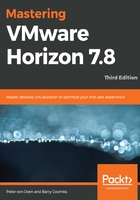
Blast Extreme
Blast Extreme is a new VMware developed protocol that uses the H.264 video codec as an option if you have the appropriate GPU acceleration resources available in the host servers, allowing it to deliver the user experience to H.264-enabled client devices. H.264, or MPEG-4 part 10, is an advanced video coding, or MPEG-4 AVC, solution. It is a standard of video compression that is block-oriented, motion compensation-based. It's a commonly used video format, and an example of where it is used is in the delivery of DVD video content.
Blast as a VMware protocol has been around for a while and was first seen in Horizon 5.2 a few years ago, where it was used to deliver HTML5 access to virtual desktop machines. Now, however, it's not just limited to delivering HTML5 access; it can also deliver the user experience to the latest client devices using standard HTTPS ports.
The Blast Extreme delivery method is also on feature parity with PCoIP and supports similar functionality, such as client drive redirection, USB, unified communications, and local printing. Where they start to differ is in resource consumption, with Blast using far fewer CPU cycles, and delivery protocols, and more flexible.
Like PCoIP, Blast Extreme can compensate for an increase in latency or a reduction in bandwidth and dynamically adjust; however, it can also leverage both TCP and UDP, whereas PCoIP is UDP only.
You can also connect multiple monitors. Depending on the endpoint device, up to four monitors are supported, each one running at 2,560 x 1,600. Or you can run three 4K monitors running at 3,840 x 2,160 for Windows 7 remote desktops with Aero disabled.
Some of the other features of Blast Extreme are detailed in the following list:
- Blast Adaptive UX: Delivers end user access to Horizon View virtual desktop machines and hosted applications via the Horizon View Client or browser-based clients, using either Blast Extreme, PCoIP, or RDP. It automatically adapts to network conditions, delivering the best experience possible, through either.
- Blast Multimedia: Delivers rich video playback for Flash, HTML5, QuickTime, Microsoft Silverlight, and Windows Media.
- Blast 3D Services: Built on the broadest virtualized graphics capabilities in the industry, including hardware-accelerated graphics with NVIDIA GRID vGPU technology. With Blast 3D enabled, Horizon View supports either up to two monitors running up to 1,920 x 1,200, or a single 4K monitor running at 3,840 x 2,160.
- Blast Live Communications: Delivers full access to communications tools such as headsets and webcams, for rich audio and video. Supports applications such as Skype, Google Hangouts, and Cisco WebEx.
- Blast Unity Touch: Delivers a more intuitive interface, allowing you to use Windows desktops, applications, and files from a mobile device.
- Blast Local Access: Supports connecting peripheral devices such as USB flash drives, printers, smart card devices, and smartphones to your virtual desktop machine.
- Blast Horizon Clients: Blast-enabled clients for delivering a high-end user experience to endpoint devices.